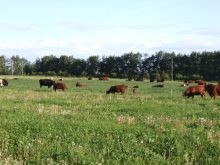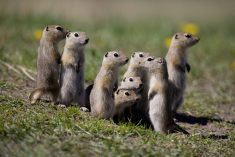In an industry where margins can be tight it’s often hard to justify the cost for something like a DNA test that seems “nice to have.” But what would the return on investment need to be to make DNA a “need to have” item on every farm and ranch?
That is a question researchers across Canada are stewing over as genotyping, genomic breed composition, and other factors affecting the genetic progress of Canada’s beef herd gather momentum.
Taking EPDs to the next level
Read Also

Body condition, nutrition and vaccination for brood cows
One of the remarkable events of the past century related to ranching has been the genetic evolution of brood cows….
Dr. John Basarab, senior research scientist with Alberta Agriculture and Forestry, and adjunct professor at the University of Alberta, and his team on the Sustainable Beef Project are looking for ways to generate genetic gEPDs and multi-trait indices that perform well in crossbred cattle. To carry that off the EPDs must be calibrated to work on crossbred cows. And that requires a lot more genetic data from a lot more cattle, including less common breeds, to create a reference database large enough to be of value to Canada’s diverse cattle population.
“This is why our work with the Americans and Irish, for example, is important,” says Basarab.
The Irish have one of the best beef genetics databases in the world thanks to their national beef improvement strategy. About 80 per cent of beef producers have signed up their calves and have agreed to nightly transfers of data from the national identification and movement system covering births, movement, slaughter and export to an integrated cattle breeding database with the aim of improving the genetics of the national herd.
Sire ID
Dr. Bart Lardner, senior research scientist at the Western Beef Development Centre (WBDC) and University of Saskatchewan students Stacey Domolewski and Crystal Ketel are in the final year of a three-year study of ways commercial beef producers can use DNA to evaluate the performance of their bulls. Six Saskatchewan ranches, including the WBDC herd, are co-operating in the study by collecting genetic samples from as many bulls and calves as possible. The objective is to find out which bulls are the most prolific at servicing their debt by producing the most saleable pounds of weaned calf.
One surprise has been the tremendous variability in performance among bulls that passed a breeding soundness evaluation. “If the bull isn’t performing, it’s costing producers money,” says Lardner. “Purchase price, feed, vet costs should all be offset by the genetic traits the bull is bringing to the herd.” Using parentage data from DNA allows producers to track each bull’s past performance so the duds can be culled before the bulls are turned out to the breeding pasture.
Collecting and using data
“Collect as much performance data as possible including birth and weaning weights, cow reproductive performance, nutrition and feed analysis,” says Lardner. Parentage testing is becoming easier to include during routine handling. “Tests are cheaper and more accessible all the time and the technology has really improved.”
Blood and hair are the most common and simple ways to collect DNA. Basarab advises recording calf and dam ID, mating group, birthdate, weaning weight and date — critical information. “This information can be used to calculate other data so it is important. And learn how to take a hair sample.”
Take samples from as many animals as possible and store them in labelled paper envelopes. “You don’t need to test it all but you will have it ready if you need it,” he adds.
The proper procedure for collecting hair samples can be found on the Delta Genomics website.
“From the progeny’s DNA test we can back-calculate the dam’s breed composition for nothing. Now we have a way to really improve breeding decisions,” says Basarab.
One of the biggest challenges in this era of data is what to do with all the information once you have it. Organizations such as GrowSafe, BIO, Cow Calf Health Management Services, Beefbooster and others offer services that collect the raw data and turn it into useful information.
Genomics at work
Claresholm, Alta. rancher Gerald Vandervalk has been using data to make his selections for more than 30 years. His father got them started when he tried Beefbooster bulls for the first time, and they’ve stayed with the program ever since.
He collects the DNA as he tags the newborn calves. “It adds a step but it works for our operation and we get our results back in time to make decisions for the coming breeding season.”
He admits the amount of data he receives from Beefbooster is almost overwhelming but he knows what traits to look for when selecting his bulls for the year. “I pick the areas I want to work on in my herd — such as birth to weaning average daily rate of gain — and make my choices based on the data available.”
The reports he receives include both expected breeding values and phenotypic data, as well as a ranking of the bulls against the group.
Of course, he’s not adverse to dipping into the genetics in the other herds by buying outside bulls. “Something I might be weak on they may have, so I like to keep a good mix.”
While the basis of all his decisions is the data, the look of the animal still plays a part in his final decision. “I think picking by the numbers is good but I don’t know anyone brave enough to do it. You still want to see the animal,” he says.
Dairy versus beef
In 2009, the Canadian dairy industry adopted the 50k SNP chip to improve the accuracy of the gEPDS for various traits. Since then the industry has doubled its rate of genetic progress which has added $200 million annually to the dairy sector through improved milk yield and butterfat content.
Granted the dairy industry has some advantages over the beef sector in that they use AI almost exclusively. This allows for the quick development of large sire families which accelerates genetic progress. The industry is also vertically integrated so improved genetics can be quickly passed along to producers instead of being diluted through a segmented system as in the beef sector. Supply management also plays a part in their success, as better performance always pays off.
“Genetic improvement at the cow-calf level doesn’t always result in more money back to the cow-calf producer,” admits Basarab. “It is essentially lost. The improvements the producer has made are not entirely valued or paid for if the calf is sold at weaning. As well, the data on that animal (feedlot performance, carcass quality) seldom makes its way back to the producer.”
This is where recording systems like BIXS, BIO and others can play a role in gathering information so producers can see the results of their genetic improvement and perhaps add some value to the cattle.
What’s next?
Research now is focused on tools like genomic breed composition, genomic hybrid vigor, gEPDs that perform in crossbred cattle and multi-trait value indices which allow producers to maintain and/or improve traits like fertility, feed efficiency, adaptability and resilience to climate change and lifetime productivity — that will add profit to their operation today.
In the bigger picture Basarab believes Canada needs a national beef improvement strategy similar to what our dairy industry has done and what the Irish have done for their beef sector. He says we are at least 15 years behind the dairy sector in this country in genomic advancement. There are purebred and hybrid breeders that are moving Canada’s herd genomics forward, but he says we still have a long way to go.
He suspects that it may take another decade of research to fully understand the benefits of these genomic tools.
Lardner, however, says the economics are already clear — the ROI is there. “Producers are looking at a cost of approximately $2,000 to develop a heifer and get the first calf on the ground. The average cost to maintain a herd sire is approximately $1,800 per year. A one-time, $20 test is a good investment in your calf crop.”
Annemarie Pedersen is a freelance farm writer living in Alberta. This article first appeared on AGCanada.com.
















